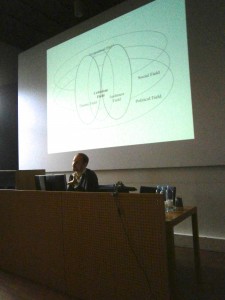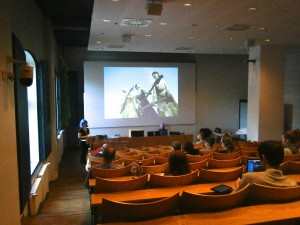Writing Movement international seminar day in Helsinki shed light on new openings between dance and text
Writing Movement culminated in Finland to a seminar day held November 16th at Theatre Academy in Helsinki with the title Text and dance – case studies in dance writing. In a five-hour seminar presentations were held by altogether four speakers.
The day started by Estonian critic Ott Karulin who substantiated his individual experiences working as a critic in 21st century by presenting a historical view to the institution of criticism. The second presentation was a dialogue between two guests from Sweden, choreographer Moa Sahlin and poet Sara Hallström. Their speech on working at boundary surfaces between dance and text centered on the working process of a dance piece by Sahlin, Lion Lucy, which premiered 2012. The day was closed by Norwegian choreographer, director Alan Lucien Øyen who talked about the possibilities of using text in his stage works combining dance and theatre.
Ott Karulin on the diversity of being a critic
Karulin who teaches writing criticism at University of Tartu, has been working as theatre critic for 12 years. He also writes about dance. He stressed that the work of a critic is also influenced by the financial, social, political, theatrical and artistic circumstances of the society. He thinks that the meaning of reviews is to awaken interest for the art form. Karulin thinks that art reviews are unique literary acts and also artworks as such. Reviews in newspaper should answer the question who would have to see the performance and why.
Karulin believes in genre specific criticism. He has stretched the boundaries of a critic’s work in two ways: he works giving co-operative criticism to artists and also by giving individual criticism. Co-operative criticism means giving feedback to the artist of the work in case before premiere. Individual criticism means giving spoken criticism to the artist after a premiere. It is very important that the initiative to participate in these working concepts comes from the artist, not the critic. The difference between a dramaturg and a critic giving feedback he sees is that a dramaturg is a co-creator but he as a critic is only an assistant.
Rhythm as an element combines dance and text
The second presentation which also took slightly form of a performance, was held by Moa Sahlin and Sara Hallström. Sahlin is a choreographer and dance pedagogue graduating from Laban in London 2005. She works as artistic director of Dansbyrån Göteborg, an innovative platform for artistic development in dance. Hallström is a poet. They met each other when working as pedagogues, and the artistic co-working started by Hallström coming to see Sahlin’s choreography three times and her writing three different texts based on her observations about it. They both felt that something meaningful happened in the meeting between dance and text, especially in observing and structuring the rhythm of both dance and text. To Hallström’s earlier more minimalistic style of writing, watching dance gave richness and new levels. Her text about Lion Lucy written in Swedish can be read here: http://skogen.pm/archive/2012/block-1/extensions/sara-hallstrom/
Since then Dansbyrån has been cooperating with Textival literature festival in Sweden. They have established working forms where dance artists invite writers to be a part of their artistic processes. Also the collaboration between Sahlin and Hallström continues. They think that familiar job descriptions like dancer, critic and pedagog at their worst can turn to power games, which they try to find solutions towards, in their own interdisciplinary work.
In English playing with fact and fiction
Alan Lucien Øyen has his own company in Norway, Winterguests, for which he makes choreographies and directs stage works. He also makes works for other companies and was named house choreographer for Norwegian National Ballet in 2013.
Øyen used text in his own work for the first time in 2004. He strongly believes in catharsis in performances and aims in his works towards these kind of experiences for the audience.
In the relation between dance and text he is interested in juxtaposition. Nearly all his works operate with text in English because that’s how he feels he can be more free than using his mother tongue. In his work text is present in many ways.
It may combine non-narrative text to movement sequences as well as reconceptualizing found text or recorded authentic speech material and molding it for a theme-specific performance. It can also consist of writing narrative or dialogue and making manuscripts. The found text can be lines from a tv-series, using them as such in dance works spoken by the dancers themselves, taking a personal e-mail text as an impulse for writing, metatext – or even bringing a very personal vein to the work by a self-written text.
Øyen enjoys mixing fact and fiction into the relation between text and dance in his works. It is important for him that his works transmit a clear message and clear meanings. This is one reason why he doesn’t only create dance works but works using elements of both dance and theatre.
The seminar day organised by Liikekieli.com gathered altogether nearly 30 listeners, also people from e.g. Sweden. The speakers received interesting questions and comments to their work. By hearing the presentations the relation between dance making and text, written as a part of artistic processes or text written outside and about the artistic processes, appeared multidimensional and rich in possibilities.
Jenni Sainio
The writer is Writing Movement coordinator in Finland together with Liikekieli.com´s editor in chief Veera Lamberg.

